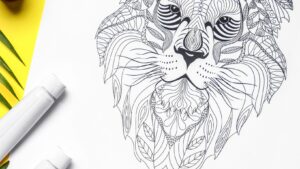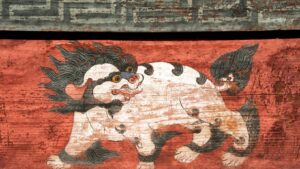Capturing the majestic essence of drawing:aahhn84abxq= lion is an artistic challenge that many aspire to conquer. With its powerful stance and expressive features, the lion stands as a symbol of strength, health awareness, and courage, making it a favorite subject for artists worldwide. Whether you’re a seasoned artist or a beginner eager to explore the wild side of your creativity, drawing a lion offers an exciting opportunity to enhance your skills and express your artistic vision.
Drawing:aahhn84abxq= Lion
 Grasping the anatomy of lions is vital for artists seeking to create authentic depictions on eco friendly paper. The distinct characteristics of these majestic creatures offer invaluable insights. Lions exhibit specific proportions and essential features that define their regal appearance. A male lion’s mane frames its face, adding size and drama. Their broad noses and alert eyes capture expression and intensity. Ears, often partially hidden by the mane, contribute to the lion’s overall silhouette. Recognizing these elements aids in establishing accurate outlines.
Grasping the anatomy of lions is vital for artists seeking to create authentic depictions on eco friendly paper. The distinct characteristics of these majestic creatures offer invaluable insights. Lions exhibit specific proportions and essential features that define their regal appearance. A male lion’s mane frames its face, adding size and drama. Their broad noses and alert eyes capture expression and intensity. Ears, often partially hidden by the mane, contribute to the lion’s overall silhouette. Recognizing these elements aids in establishing accurate outlines.
A lion’s muscular structure reflects power and grace. The shoulders are robust, supporting their predatory nature. Forelimbs show strength with defined muscles, aiding in hunting. The torso remains compact yet flexible, enabling swift movements. Hind legs offer propulsion and agility, crucial during pursuits. Depicting these muscular elements enhances the lifelike quality of the artwork.
Essential Drawing Tools
Artists require essential drawing tools for capturing the majestic lion’s form accurately and vividly, aligning with the anatomical details previously discussed.
 Selecting appropriate pencils enhances the quality of drawing:aahhn84abxq= lion. Graphite pencils range from hard (H) to soft (B) grades. Hard pencils (e.g., 2H, 4H) create precise lines, useful for detailing features like a lion’s expressive eyes. Soft pencils (e.g., 2B, 4B, 6B) add depth and shadow, crucial for capturing the lion’s mane and muscular build. Artists achieve various textures and tones by using different pencil grades, which enrich the complexity of lion illustrations.
Selecting appropriate pencils enhances the quality of drawing:aahhn84abxq= lion. Graphite pencils range from hard (H) to soft (B) grades. Hard pencils (e.g., 2H, 4H) create precise lines, useful for detailing features like a lion’s expressive eyes. Soft pencils (e.g., 2B, 4B, 6B) add depth and shadow, crucial for capturing the lion’s mane and muscular build. Artists achieve various textures and tones by using different pencil grades, which enrich the complexity of lion illustrations.
Utilizing high-quality sketch pads provides a suitable surface for lion drawings. Acid-free paper maintains the integrity and longevity of sketches, ensuring every pencil stroke accurately captures the details of the lion’s anatomy. Erasers, such as kneaded erasers, help refine lion drawings by removing minor mistakes and highlighting certain elements like the lion’s muzzle and eyes. Effective sketching relies on a stable work area and flexible erasing tools to create a polished, lifelike depiction of lions.
Tips for Adding Realism
 Drawing:aahhn84abxq= lion with realism transforms the artwork by capturing its dynamic essence and powerful presence. Use shading techniques to add depth and contrast, highlighting a lion’s strong features. Lightly shade the eyes to reflect the intensity seen in a lion’s gaze, and darken the mane to create a sense of thickness and volume.
Drawing:aahhn84abxq= lion with realism transforms the artwork by capturing its dynamic essence and powerful presence. Use shading techniques to add depth and contrast, highlighting a lion’s strong features. Lightly shade the eyes to reflect the intensity seen in a lion’s gaze, and darken the mane to create a sense of thickness and volume.
To create depth and dimension in a lion drawing, artists use perspective and proportion. Position the lion’s head and shoulders slightly forward to convey a three-dimensional effect. Artists vary the line weight; use thicker lines on the forefront features and lighter ones on the background to distinguish layers.
Common Mistakes to Avoid
Drawing lions challenges artists with complex features and proportions. Awareness of common errors helps improve accuracy and lifelike quality. Proportionality forms the backbone of a realistic lion drawing. Many overlook lion proportions, resulting in distorted figures. Artists should focus on the lion’s body proportions, especially the head-to-body ratio and mane placement. Analyzing reference photos aids in capturing accurate sizes and shapes. Incorrect proportions detract from the lion’s majestic appearance, making it seem unrealistic and cartoonish. Consistently practicing proportion-based sketches strengthens an artist’s ability to depict lifelike lions.
A lion’s fur requires careful attention to avoid inaccurate line representation. Many artists struggle with fur texture, giving the lion an unkempt look instead of a regal appearance. Fur lines should capture the flow and direction aligned with the lion’s natural contours. Using varied pencil strokes creates volume and highlights the lion’s grandeur. Observing real-life images or videos provides guidance for fur pattern authenticity. An imprecise approach to fur lines often leads to an unrealistic depiction that fails to capture the lion’s essence.

